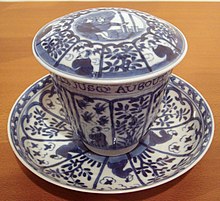Chinese export porcelain
As Chinese porcelain order (French Chine de commande, Eng. Chinese export porcelain ) is referred to a specially ordered from another country in Imperial China, where custom built and shipped, and the principal Porzellangut. Usually, the term refers to the mass export of Chinese porcelain to Europe in the 17th and 18th centuries. But earlier pieces have already been handed down for India and the Arab world, and after gaining independence, the Americans began to order their own decorations in China.
History
Chinese Porcelain for the European market from the 17th and 18th century
Due to the commercial activities of the major European trading companies operating and art of porcelain in Europe had become a sought-after items in the second half of the 17th century and the 18th century ( mainly under the influence of the ever-expanding cross- consumption of tea, coffee and chocolate ) increased to a veritable mania China. Instead of being limited to the production of their own designs and shapes, the Chinese also work on direct orders started out. In addition to manufactured for the Japanese tea ceremony pieces or plates with Koranic inscriptions for the Islamic countries by Chinese Factories Porzellangut ago, the - was adapted to the special taste of their European customers - usually after the sent drawings for the decor, but also according to pattern pieces. Especially since the beginning of the 18th century provided the Chinese commodities for the master's table, body care and furniture to all major rulers and noble families of Europe. These were mostly decorated with the arms of the customer, for which colored sketches were sent to China when ordering. Such emblem service are still preserved in Germany, about the extensive service with the Great Coat of Arms of the Prussian royal house, which came in the mid- 18th century, with ships of the Prussian Asiatic Company from Guangzhou to Europe. In the order processing could lead to problems in the long distance and the considerable cultural differences. A special Kuriosium here is a plate with the arms of de Andros Guernsey family, where the actual colors should be used, with the words " green, blue, red" is provided. As part of the increased construction of porcelain manufacturers in Europe, the porcelain trade with China fell sharply, so that the golden age of Chinese porcelain commissioned towards the end of the 18th century can be considered finished.
Exports to non-European countries
For India, the Mughals in the 16th and 17th century Chinese porcelain obviously greatly appreciated, vessels are in " Mughal - style " survived. Operated with Persia and the Arab countries, the Chinese also a lively porcelain trade and there are many pieces with calligraphic inscriptions and verses from the Koran.
After the end of the American Revolutionary War, the Americans began to build its own China trading. During the import of Chinese porcelain was settled before the war mainly over Europe, reached 1784, the first American into Port Canton. Among the ordered by the Americans decors the eagle motif and the coats of arms of the individual American states were particularly popular. Since the early 19th century, Europe was replaced by the United States as the most important market for Chinese porcelain.










